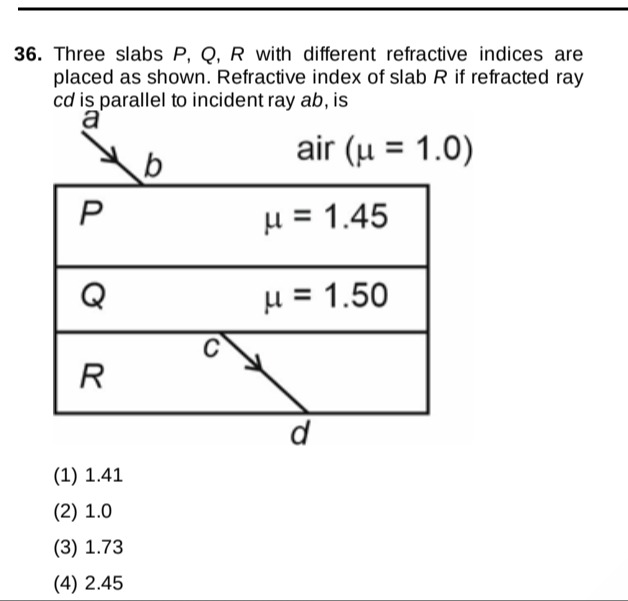Question
Question: Three slabs *P, Q, R* with different refractive indices are placed as shown. Refractive index of sla...
Three slabs P, Q, R with different refractive indices are placed as shown. Refractive index of slab R if refracted ray cd is parallel to incident ray ab, is

1.41
1.0
1.73
2.45
1.0
Solution
We want the ray “cd” in slab R to be parallel to the incident ray “ab” in air. For a plane‐parallel arrangement the emergent ray (or a ray inside slab R if specified) would be parallel to the incident ray only if the last refraction “restores” the original angle. In other words, if “cd” makes an angle equal to the incident angle i with the normal, then, from the final (R–air) boundary we must have
n_R sin r₃ = 1·sin i
But in slab R the ray makes an angle r₃ and we demand that for “cd” to be parallel to “ab” we require r₃ = i.
Substituting we get
n_R sin i = sin i ⟹ n_R = 1 (provided sin i ≠ 0).
Let us verify the consistency through the successive interfaces. The ray entering slab P (with n = 1.45) from air obeys
sin i = 1.45 sin r₁ ⟹ sin r₁ = sin i/1.45.
At the P–Q interface (slab Q with n = 1.50):
1.45 sin r₁ = 1.50 sin r₂ ⟹ sin r₂ = (1.45/1.50)·(sin i/1.45) = sin i/1.50.
At the Q–R interface:
1.50 sin r₂ = n_R sin r₃ ⟹ 1.50 · (sin i/1.50) = n_R sin r₃ ⟹ sin i = n_R sin r₃.
Now, setting r₃ = i gives exactly
sin i = n_R sin i ⟹ n_R = 1.
Thus the refractive index of slab R is 1.0.
Core Explanation:
Successively apply Snell’s law at each interface. The condition that the ray inside R (angle r₃) is parallel to the incident ray (r₃ = i) forces
n_R sin i = sin i,
hence n_R = 1.
